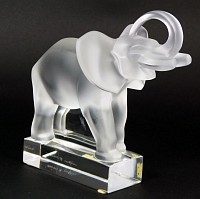BIOGRAPHY

Rene Jules Lalique, French (1860-1945)
Rene Lalique’s life and artistic career bestrode arguably the three most important movements in the field of the Decorative Arts – Belle Epoque, Art Nouveau and Art Deco. His contemporaries, Emile Galle and the American, Louis Comfort Tiffany, worked predominantly in Art Glass, distinctive for its rich interplay of color, botanic motifs and iridescence. These facets, although of great beauty, tended somewhat to disguise the medium of glass itself. Rene Lalique, however, stood out from his contemporaries by being the ‘purist’, who applied his talent to the inherent merits of glass, and thereby elevated it to new heights of technical and artistic interpretation.
Lalique was born on 6th April 1860, in the small French town of Ay in the Marne region. While still an adolescent, he won several awards for his illustrations, and by 1890 had achieved an enviable degree of success as a silversmith, goldsmith, enameler, sculptor, designer and of course as a jeweler. It was in this latter field that he first gained worldwide renown, however, glass held the greatest fascination for Lalique and the advent of the 1920′s witnessed the period of his greatest commercial success.
Many truly astonishing items of glassware were produced, including a range of glass car mascots, mainly of female nude or animalier form. Lalique had shrewdly recognised the vogue for “automobiles de luxe” and offered its devotees his sensual mascots as the ultimate automotive adornment. Some of these mascots are today extremely rare and are amongst the most valuable of Lalique’s work from this period. During these years the world’s most discerning connoisseurs sought out Lalique to add his indefinable genius to their interiors, and his patrons included Indian maharajahs, American industrialists and European nobility, as well as almost all of the surviving crowned heads of Europe’s Royal Houses.
Of all the eulogies and posthumous praise heaped on Lalique after his death, one is most worthy of recounting here. One of Lalique’s greatest friends and lifelong patrons, the Armenian oil mogul Calouste Gulbenkian wrote “He ranks among the greatest figures in the history of art of all time …” From Gulbenkian, whose art collection included works by Rubens, Rembrandt, Rodin and Gainsborough as well as some of the finest works by Lalique – this was praise indeed.
